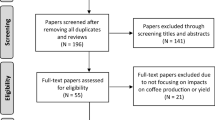Abstract
Selection of rice varieties with wide adaptability over diverse farming environments is important, prior to varietal recommendation in order to achieve a high rate of varietal adoption particularly in developing countries. Multi-locational rice varietal adaptability trials conducted in farmers’ fields consist of only few varieties and minimum replicates within a location. The statistical methodology available at present for analysis of these trials is inadequate. This paper proposes an efficient and simple method to analyse on-farm multi-locational yield trials with few varieties and minimum replicates, for evaluating wide adaptability and stability of rice over diverse environments. In the present method of analysis, deviations of the plot yields from the maximum plot yield in a given environment are computed and a pooled analysis of variance is run on these deviations. Mean deviation (D) and variance in deviations (v2) across locations for each variety are computed. Varieties are evaluated for general adaptability using D and v2, the stability parameter. Variety with the lowest D and non-significant v2 is selected as the most adaptable variety in the test since it is the one with the highest yield in all environments. The present method is illustrated in comparison with the most appropriate reference method that provides a parameter called ‘superiority measure of varietal performance’ on on-farm yield trials in rice. While retaining the advantages of the reference method, the present method has an additional advantage of efficient and precise detection of varietal differences in their adaptability over diverse environments in an objective and realistic manner.
Similar content being viewed by others
References
Abeysiriwardena, D.S. de Z., G.R. Buss & P.F. Reese, jr., 1991. Analysis of multi-environmental yield trials for testing adaptability of crop genotypes. Trope Agriculturist 147: 85–97.
Das, G.R.,1982. A method of scoring yield status for selecting rice cultivars. Indian J Agric Sci 52(4):207–209.
Dudewicz, E.J., 1996. Introduction to statistics and probability. Halt, Rinehart & Winston. 120–122 pp.
Eberhart, S.A. & W.A. Russell, 1966. Stability parameters for comparing cultivars. Crop Sci 6: 36–40.
Finlay, K.W. & G.W. Wilinson, 1963. The analysis of adaptation in plant breeding programs. Aust J Agric Res 14: 742–754.
Gower, J.C., 1966. Some distance properties of latent root and vector methods used in multivariate analysis.Biometrika 53: 325–338.
Grafius, J.E. & R.L. Kiesling, 1960. The prediction of the relative yields ofdifferent oat cultivars based on known environmental variables. Agron J 52: 396–399.
Kroonenberg, P.M. & K.E. Basford, 1989. An investigation of multiattribute genotype response across environments using threemode principal component analysis. Euphytica 44: 109–123.
Lin, C.S. & G. Butler, 1990. Cluster analyses for analyzingtwo-way classification data. Agron J 82: 344–348.
Lin, C.S. & M.R. Binns, 1988. A measure ofcultivar general superiority for cultivar × environment data. Can J Plant Sci 68: 193–198.
Lin, C.S. & B. Thompson, 1975. An empirical method of grouping genotypes based on linear function of the genotype-environment interaction. Heredity 34: 255–263.
Nene, Y.L., 1993. On-farm adaptive research and technology exchange.In: L.L. Gowda, C.E. van Santen, C. Johansen & S.N. Nigam S.N. (Eds.), Approaches to On-Farm Research in Asia: Summary Pro Reg Workshop on Adaptive Research, 18–20 Feb. A.P. 502 324, India: International Crop Research Institute for the Semi-Arid Tropics.
Perkins, J.M. & J.L. Jinks, 1968. Environmental and genotypeenvironmental components ofvariability. Heredity 23: 523–535.
Plaisted, R.L.,1960. A shorter method of evaluating the ability ofselection to yield consistently over seasons. Am Potato J 37: 166–172.
Shukla, G.K., 1972. Some statisticalaspects of partitioning genotype-environmental components of variability. Heredity 29: 237–245.
Snedecor, G.W. & W.G. Cochran, 1980. Statistical methods. 7th ed., The Iowa State University Press. 73–74 pp.
Tai, G.C.C.,1971. Genotype stability analysis and its application to potato regional trials. Crop Sci 11: 184–190.
Williams, E.J., 1952. The interpretation of interactions in factorial experiments. Biometrika 39: 65–81.
Wricke, G., 1962. Uber eine Methode zur Erfassung der ökologischen Streubreite in Eldversuchen. Z Pflanzenzücht 47: 92–96.
Author information
Authors and Affiliations
Rights and permissions
About this article
Cite this article
de Abeysiriwardena, D.S. Statistical analysis of on-farm yield trials for testing adaptability of rice. Euphytica 121, 215–222 (2001). https://doi.org/10.1023/A:1012007906425
Issue Date:
DOI: https://doi.org/10.1023/A:1012007906425




